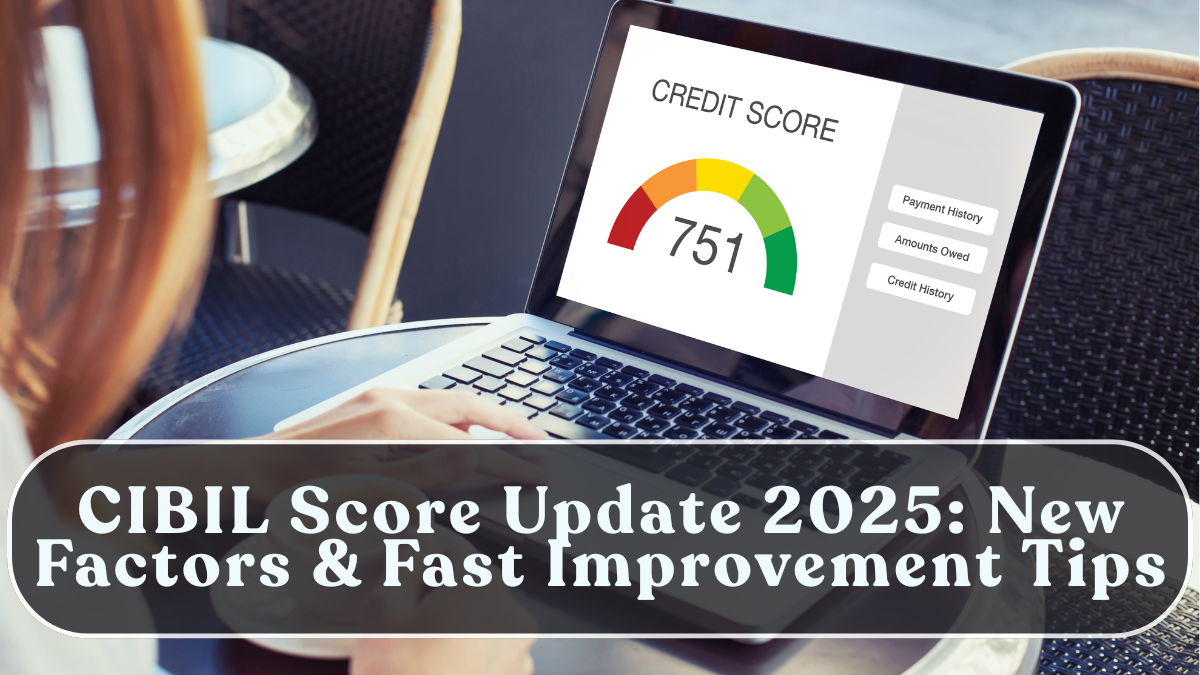In 2025, the CIBIL score update has brought key changes to how banks and lenders assess your creditworthiness. The TransUnion CIBIL system now includes newer behavioral factors beyond just timely EMI payments. From utility bill tracking to credit utilization and spending consistency, your financial habits now play a greater role in determining your score.
Here’s a detailed breakdown of what’s new, what affects your CIBIL report in 2025, and how you can boost your score quickly for better loan eligibility.

What’s New in the 2025 CIBIL Score Update
The CIBIL algorithm has evolved to provide a more accurate reflection of a person’s financial reliability. Key updates include:
-
Expanded Data Sources: Utility bills, rent payments, and digital loan apps are now tracked.
-
Credit Behavior Monitoring: Frequent small loans, late payments, or inconsistent credit use can lower scores.
-
New Scoring Range Sensitivity: A few late payments can drop your score more sharply than before.
-
Active Loan Mix Factor: A balanced combination of secured (home, car) and unsecured (credit card, personal loan) accounts improves score stability.
-
Real-Time Reporting: Lenders now share repayment data faster—your score updates within 24–48 hours of payment.
These changes aim to help responsible borrowers stand out while identifying risky credit behavior earlier.
How Banks Are Assessing Creditworthiness Now
Banks and NBFCs in 2025 are relying on behavioral and pattern-based data, not just raw numbers.
Here’s how it impacts loan approval:
-
Consistency over Time: Maintaining stable credit behavior for 6–12 months matters more than a short-term score jump.
-
Debt-to-Income Ratio (DTI): Borrowers with DTI above 40% are flagged as high-risk.
-
New Account Frequency: Opening multiple new credit cards or BNPL (Buy Now Pay Later) accounts lowers trust levels.
-
Utility and Subscription History: Regular payment of electricity, postpaid, or OTT subscriptions builds reliability.
Essentially, lenders now focus on long-term discipline rather than one-time corrections before applying for loans.
Quick Ways to Improve Your CIBIL Score in 2025
Even with tighter scrutiny, improving your score remains absolutely achievable. Here’s how you can give your score a fast and sustainable boost:
-
Keep Credit Utilization Under 30% – If your card limit is ₹1 lakh, keep spending under ₹30,000 monthly.
-
Automate Bill Payments – Use auto-debit for EMIs and utilities to ensure you never miss due dates.
-
Avoid Frequent Credit Inquiries – Too many loan or card applications can reduce your score instantly.
-
Close Old Debts Gracefully – Pay off small loans completely and keep older credit cards active to maintain long credit history.
-
Diversify Your Credit Mix – A combination of short- and long-term loans improves score stability.
-
Use Credit Builder Cards – If your score is low, secured credit cards linked to deposits can rebuild your profile quickly.
These small but consistent changes can show improvement within 60–90 days.
Understanding the New Factors Affecting Your CIBIL Score
In 2025, the score algorithm gives greater weightage to certain new behaviors:
-
Digital Lending Apps: Loan defaults or delays on fintech apps like KreditBee or Slice are now reported to CIBIL.
-
Credit Age: Older accounts build trust; closing them early can reduce your score.
-
Installment-to-Limit Ratio: High EMI burden signals risk even if you pay on time.
-
Co-signed Loans: Default by a co-borrower or guarantor now directly affects your profile.
Regularly checking your credit report for discrepancies is essential—CIBIL errors can still occur due to delayed lender updates.
Impact on Loan and Credit Card Approvals
The new system gives banks a more holistic borrower profile, meaning your behavior across multiple platforms matters.
-
Home loans now require scores above 750 for better rates.
-
Credit card pre-approvals depend on both score and spending discipline.
-
Salary and employment stability are cross-verified with your credit data in 2025’s advanced scoring model.
Lenders are also using AI-based screening to spot unusual spending patterns, reducing fraud and defaults.
Conclusion
The CIBIL score update 2025 marks a major shift toward behavior-driven evaluation. Instead of focusing only on payments and outstanding loans, the new model rewards consistent financial discipline, transparency, and balanced credit use.
By maintaining steady repayments, low utilization, and diversified credit, you can build a strong score that opens doors to cheaper loans, higher limits, and instant approvals in today’s data-smart lending environment.
FAQs
What’s the ideal CIBIL score for 2025?
A score of 750 and above is considered excellent for most banks and credit card issuers.
How long does it take to improve my CIBIL score?
With regular payments and low utilization, you can see results within 2–3 months.
Do utility bills now affect CIBIL score?
Yes, from 2025, utility and rent payments are included in your score calculation.
Can I remove old loan defaults from my report?
No, defaults stay for up to 7 years, but their impact reduces as you maintain positive credit history.
Is checking my CIBIL score frequently harmful?
No, checking your own score is a soft inquiry and does not affect your score at all.
